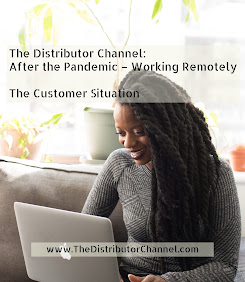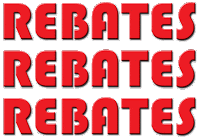After the Pandemic – Working Remotely The Customer Situation
After the Pandemic – Working Remotely
The Customer Situation
The distributor world revolves around customer needs. Our
customer needs are an ever-evolving thing. Knowledge-based distributors exist exclusively because of our willingness to follow, and sometimes, lead customers through their changes. Thinking about the evolution of distributors, before the early-80s distributors all operated about the same. Their sales efforts were mostly personality-driven and local inventory was the drawing card.To illustrate this, allow me to journey back to the early
days of my career. The standard delivery
from my factory in Milwaukee to Iowa – just over 200 miles – was five working
days. If a distributor did not have the
product in stock, the customer could be out of business for a week. This all changed when UPS and Fed-Ex entered
the scene. With local inventory out of
the equation, smaller independent distributors took a different approach. They built expertise around core products
offering expert assistance tied to the products they sold.
This played well as customers went through what was known as “re-engineering” their organizations as outlined in Michael Hammer’s 1993 book, Reengineering the Corporation: Manifesto for Business Revolution. Engineering, maintenance, and technical teams were often re-engineered/downsized (bent, folded, stapled, and otherwise mutilated) to the point of resembling nothing of their former condition. Early adopters of the expertise model were joined by other distributors in becoming what is commonly referred to today as a Knowledge-based distributor.
These dramatic shifts in customer behavior, as in the
case of the re-engineering mentioned above, were propelled by economic
storms. Since the recessions of the late
80s and early 90s, the distribution business model has further morphed with
each new economic storm. Make no
mistake, the COVID Pandemic will live in infamy as a whopper of a storm. Ignoring customer shifts driven by this
phenomenon can lead to devastating consequences. Those distributors who pause to consider the
shifts and prepare for them will outperform their peers.
Join me as we explore what is happening and how to
prepare for one of the biggest changes.
Customers working remotely
According to new numbers from World Economic Forum, 75
percent of workers want to maintain a certain level of “flex time” after the
dust of the Pandemic dies down. Surprisingly,
74 percent of managers are in favor of the idea. The economics involved in finding qualified
workers will force many customers to follow the flex time practice with many of
the jobs that typically report to the office.
While maintenance, production, and shop floor technicians
will continue to report to work daily due to the hands-on nature of their work,
the rest of our customer contacts have a high probability of becoming flex
workers. This presents some issues for
distributors.
Customer contact will require greater use of
appointments
After a year with extraordinarily few or no customer
visits, most sellers report an urge to jump into the car and drive like the
wind to the nearest customer. Thinking
further, most of the in-person calls made during the Pandemic were at the
request of the customer. Scheduling was
easy, the customer called, asked the seller to come look at some situation, and
off they went. Basically, the customer
made the appointment.
Past research with dozens of traveling supplier
salespeople uncovered a systemic issue with distributor salespeople. Most are not good with targeted
appointments. Some are still “milk
route” sellers, substituting their ability to show up every Tuesday for actual
appointments. Pre-COVID these guys
wasted a lot of time for the customers to meet with them. Things will be worse in a post-COVID world. Flex workers may or may not be present; those
who are in the facility will be consumed with other activities. The only answer is developing (or
redeveloping) the habit of setting appointments.
One of the underlying reasons appointments are not used may
be a lack of planning. Setting
appointments has always been difficult and I suspect some gave up because they
saw the arduous nature of the task as not worth the effort. Here are a couple of pointers on setting
appointments:
·
Always have a clearly defined and
customer-focused reason for your appointment. Just stopping to say “hi” is probably not
going to cut through the clutter. If you
do not have a reason to visit, create one.
Remember, there must be something in it for the customer. And customers do not value new product
introductions as highly as back in the “good old days.”
·
Whenever possible confirm a time for your
next visit with the customer. This
could be as simple as saying, “I have a few things to research for you. Is there a good day and time for us to get
back together?”
·
Use text messages to set appointments. Younger customers report they prefer texts
for activities like this. A quick text
with a proposed date and time can avoid a lot of phone tag.
·
Use email and outlook invites. Send a meeting request along with a message that
you would be open to a different time if the original time does not work.
multiple calls. In our work with new sellers working in underdeveloped territories, we have discovered that a single call rarely results in getting an appointment with a prospective customer. The question these sellers ask is this: How many calls are too many? Our research indicates it takes as many as seven phone calls to reach a person these days. Really.
Customers are ditching their catalogs
Back in June of 2013, I wrote this:
“Every engineering department, maintenance group or contractor on the planet still maintains a library of product catalogs. Even though a good many turn to the internet for some level of product selection, they ultimately end up with a hard catalog for the final stages of their decision making.”Later in the article, I even provided advice to new sellers on how to properly place their company’s sticker on the catalog. What a difference seven or eight years makes.
Finally, after 100 years and one global Pandemic,
customers are ultimately ditching their collection of grease-covered, beat up
old catalogs. Research indicates that
even maintenance techs, who generally do not have a dedicated work computer,
are now given access to a departmental computer for researching parts and
determining potential replacements. But
those flex workers have not taken their giant stack of catalogs home. Instead, they are using the internet as their
primary tool for product identification and selection.
A recent survey we conducted with (mostly electrical and
automation) customers including panel builders, systems integrators, special
machine builders, OEMs, and end-users demonstrated the impact of the
internet. 100 percent of those surveyed
indicated buying decisions were made via the web. Most had two or three preferred distributors
and tried to use the webstores of those companies to gather the information
required for their projects. Pushing
this forward, we asked if they found themselves migrating toward the
distributor with the most complete webstore.
The discovery: for flagship
brands, the purchases remained at the original distributor, but ancillary and
“commodity” purchases were moving to the distributor with the most complete
webstore.
The moral of this story is this:
·
If you do not have a webstore: The Pandemic has just dealt you Wild Bill Hickok’s
aces and eights. You need one and you
need it right away.
·
If you do have a webstore: Now is the
time to get good at e-commerce.
Distributors with a webstore should invest the same
energy in getting customers onto your site and familiarizing them with
navigation as many of us did back in the “catalog with a sticker” days.
Customers still need Training… and Training is
still the new marketing
Whether working remotely or in their office, customer training
will be in high demand. Customers
working from home will be searching for easy-to-understand training that could
be delivered via videos over the internet.
A recent study published by KPMG (the global business
services company) states that in 1995 only 4 percent of companies used online
learning. Midway through the Pandemic
the number had exceeded 90 percent and continues to grow. This provides an opportunity for
distributors. Here is why.
In a complex technical class, the right level of training
and retention often requires a person to answer individual questions. While large “training providers” may have a
team of generic subject matter experts, most have no connection to the customer
and little understanding of the customer’s application. Distributors are perfectly suited to handle
these types of technical questions.
Further, each such interaction has the potential for furthering the
sales relationship. Technical
specialists and application engineers already on staff can easily field
questions and at the same time understand the new technologies remotely working
customers are exploring. Training as the
new marketing illustrated.
Some types of training cannot easily be done online whether the student works in the customer facility or remotely. On-site distributor-hosted training is the ultimate marketing tool. When distributors can get customers into their offices for training, the customer is exposed to the distributor’s company culture, see related products, and build relationships with support people. Essentially, the customer drives to the sales call instead of the other way around.
Bringing all this together
The Pandemic aftermath will linger with our
customers. More will work remotely while
employing some sort of flex work.
Customers will continue to embrace the speed and convenience of the web
for finding product details. It will be
harder to see people without an appointment.
And, not making an appointment will ultimately create friction in the
sales process.
As knowledge-based distributors, it is our duty,
responsibility, and mission in life to make our customer’s lives easier and more
productive. Anticipating these shifts
will create a new competitive advantage.
Next time
Long ago an old faded, hand-painted billboard along US 151 in western Wisconsin read, “Crazy Frank’s Discount – Eliminate the Middleman and Save!” I liked the name. Each of the hundreds of times I passed by it reminded me, we are the middleman they were talking about. Distributors generally serve our customers, but we also serve the supply-partners we represent. The pandemic has impacted them.
Next week, we will take a similar look at their people situation.
Make sure to subscribe at the top left to get the next installment hot off the presses! No spam, promise.
Consulting. He combines the battle scars of 28 years of front line "in the trenches" experience with over 13 years of service to knowledge-based distributors and their manufacturer partners.
Email or call today to make these virus-driven times work for you.
.








Comments
Best Regards,
Clipping Path Services
Clipping Path
Best Regards:
clipping path service